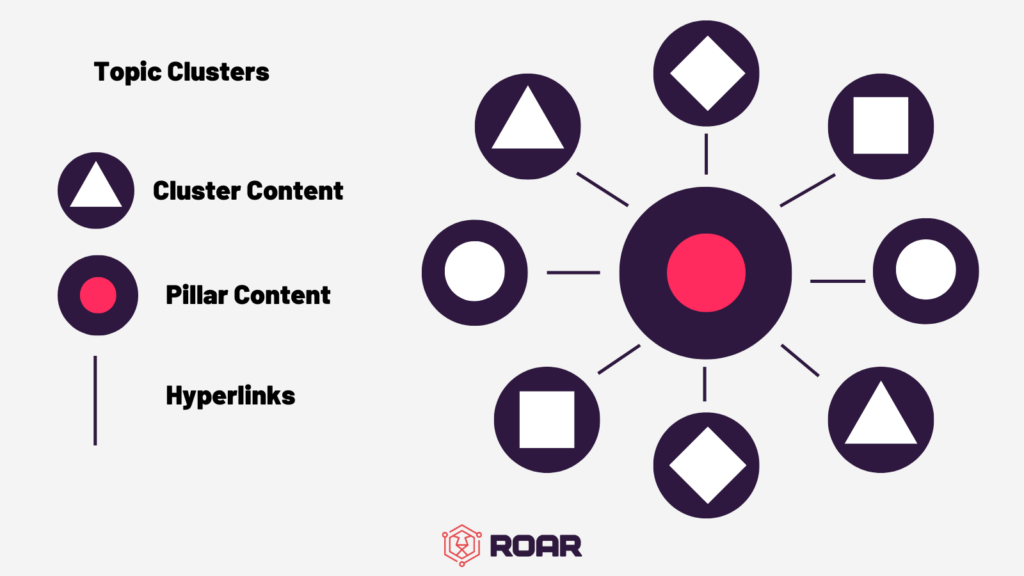
-
Cora Dixon
- 5 Min Read
- Blog, Content Creation, SEO
How to Create Content Clusters for SEO like a PRO
Search Engine Optimisation is constantly evolving and changing. One of the most exciting and essential evolutions is using content and topic clusters. In the first of a two-part series, we will break down how to create content clusters.
What is cluster content?
A content or topic cluster is an SEO strategy that optimises a website’s structure. It organises the internal linking between web pages based on website pillars or cluster pages.
Organising content like this allows Google to establish a relationship between pages quickly. A brand will be able to build its authority around a topic instead of just a single keyword. This can result in increased search visibility and a higher ROI based on your marketing efforts.
The Pillar Content page is what the cluster content pieces are built on. It covers all aspects of the chosen topic leaving room for cluster content to dive in further. The pillar page content is longer than most blog posts because they intend to cover all points for the topic you’re attempting to rank.
Custer Content is pieces of content which are more in-depth and detailed. They answer specific questions or queries about your broad topic whilst linking to the pillar page.
Hyperlinks are links from one web page to another. They help search engines and users understand the relationship between different pieces of content.
Here’s a content cluster example that breaks it down further.
Above, you can see the link between pillar content and cluster content is essentially stuck together through a hyperlink.
Here’s an example: imagine your business is a veterinary clinic, and you’re seeking to rank and drive more traffic to content around dog nutrition and health. Consider creating a substantial long-form piece of informative content on this topic for your pillar page.
The cluster content then takes the role of breaking down the topics covered in the pillar content. Each new post could focus on a topic briefly mentioned.
You could have a cluster of content pages on fitness for dogs, nutritious foods for dogs, how to ensure your dog is living a healthy lifestyle etc.
Each content cluster topic will be hyperlinked in the body of the text to the pillar content. This enables you to create a solid internal connecting framework for users to find your content.
Develop clusters around topics your business hopes to compete in. Follow this by ensuring you conduct appropriate keyword research. Keyword research is vital to rank highly and organically for the topics you discuss. These cluster pieces will link to one another and back to the pillar content.
How to create content clusters for SEO like a PRO
There are a few steps you can take in creating content clusters. This section will break these steps down to ensure you have the proper knowledge and know how to create content clusters.
- Review what your company currently offers before implementing any new strategies.
Your business must be fully aware of the products and services they provide to customers. Ensure you and your team fully understand what you offer, why and how.
Let’s say your company sells makeup products, and you hope to begin offering skincare. You will need to consider this when conducting a full business review.
Determine what you are offering your clients. What do you want to sell or offer going forward? These will be the topics you base your pillar article on and, subsequently, your topic clusters and content pages going forward.
- Create pillar content – It’s time to get those cogs turning and brainstorm topic ideas for both your pillar and clusters.
Try and come up with about 5-10 depending on how advanced your team or website is. However, you must ensure they are relevant to your current selling.
Try choosing a niche pillar; let’s revisit our earlier example of the makeup brand wanting to sell skincare. If you select pillar content focused around the words ‘what is skincare,’ you may as well just kiss Google’s first-page goodbye.
To create a niche pillar cluster content strategy here, consider topics like ‘how to replenish your skincare in 2022’ and ‘how to find quality skincare online.’
Topics like these would pair well with original content like ‘the ten skincare products you need this summer or ‘how your skincare can self-care your soul.’
Writing unique content that most businesses aren’t covering will take your business further online. This is down to building up your domain authority, expertly showing how valuable your content is.
Pillar pages and content clusters allow the creation of content covering more essential topics. Consider the issues and topics you may have been scared of writing about due to the fear of not ranking.
Now, instead of having one article covering a topic, you have a variety of content. Then each piece of content is hyperlinked to support the topic and provide support in the rankings.
- Create your cluster content – successful cluster content relies on the organisation of content and staying up to date with posting.
There are a few ways you can do this in your team to ensure a successful pillar and cluster content strategy.
You can write the content in-house, or you can dedicate a team member to producing the content. Alternatively, you can outsource the content by using freelancers or blog writing services.
You may also consider using AI, including an automated content generator.
- Create the internal links between your pillar and content cluster within your posts.
The internal linking on your website is crucial to ranking highly on Google. Internal links allow you to present related content an audience may find helpful or interesting to the user. This is a great way to push other content whilst keeping a user active on your website.
It will also aid search engines in determining which content is related and ultimately deciding on its value. Remember that your cluster content pages should link together, not just to the pillar content. This is to show the relations between them all.
This shouldn’t be too difficult as cluster content should already have an underlying link between them. If you find yourself stuck with no way to link content together on your website, consider that this piece of content may not be suitable for your website, It’s not you; it’s them.
When linking your content together, don’t go crazy throwing links out like Oprah throws out gifts. A top tip from ROAR Digital Marketing is ensuring that links are relevant and valuable.
The more links a significant page receives, the more important and valuable Google will see it as. This will result in a boost in online visibility and organic ranking.
This was part one of our topic clusters series that discussed how to create content clusters. Keep a look out on the ROAR Digital Marketing blog for part two, where we look at the importance of creating content clusters.
Take a look at our SEO Bomb® service. A one-of-a-kind, unique service to aid your topic cluster content strategy. Get in contact, and our team will tailor your topic clusters around your chosen pillar content.






